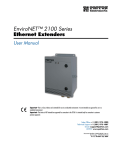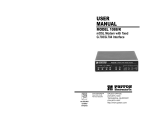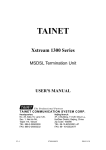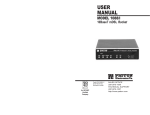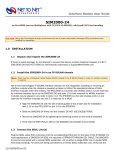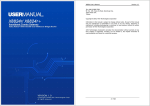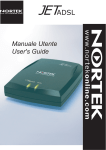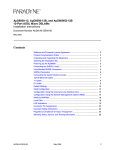Download X7005Q User manual
Transcript
X7005Q ADSL USB MODEM Copyright© 2002 XAVi Technologies Corporation All rights reserved. Table of Contents ABOUT THIS MANUAL .......................................................................................................................... 1 PREFACE................................................................................................................................................ 2 X7005Q DSL USB MODEM MANUAL ..................................................................................................... 2 CHAPTER 1: OVERVIEW...................................................................................................................... 3 ABOUT ADSL ........................................................................................................................................ 3 PROTOCOL AND DEVICE DRIVER SELECTION ........................................................................................... 3 FEATURES ............................................................................................................................................. 5 CHAPTER 2: HARDWARE AND SOFTWARE INSTALLATION ........................................................ 6 HARDWARE INSTALLATION ...................................................................................................................... 7 SOFTWARE INSTALLATION ....................................................................................................................... 8 CHAPTER 3: CUSTOMIZING COMMUNICATION SETTINGS .......................................................... 12 CHAPTER 4: CONTROL PANEL APPLICATION .............................................................................. 13 CHAPTER 5: UNINSTALLATION ....................................................................................................... 15 APPENDIX A: MODIFYING TCP/IP NETWORKING OPTIONS......................................................... 17 WAN USB DRIVER .............................................................................................................................. 17 Microsoft Windows 98, First and Second Editions ................................................................... 17 Microsoft Windows 2000 .......................................................................................................... 20 Microsoft Windows Me ........................................................................................................... 223 LAN USB DRIVER ............................................................................................................................. 245 Microsoft Windows 98, First and Second Editions ................................................................. 245 Microsoft Windows 2000 ........................................................................................................ 267 Microsoft Windows Me ........................................................................................................... 289 ATM USB DRIVER............................................................................................................................. 301 Microsoft Windows 98, Second Edition .................................................................................. 301 Microsoft Windows 2000 ........................................................................................................ 323 Microsoft Windows Me ........................................................................................................... 345 APPENDIX B: POINT-TO-POINT PROTOCOL OVER ETHERNET................................................. 367 APPENDIX C: SPECIFICATIONS ...................................................................................................... 378 APPENDIX D: FCC/INDUSTRY CANADA REQUIRED INFORMATION ........................................... 39 FCC REQUIRED INFORMATION.............................................................................................................. 39 INDUSTRY CANADA REQUIRED INFORMATION ......................................................................................... 40 About This Manual This manual provides a comprehensive user’s guide and installation manual for X7005Q DSL USB Modem. It has been organized in such a way to make it easy to be followed by users worldwide. In order to ensure optimal comprehension, the following list provides brief descriptions of the terms used throughout the manual. Commands: Commands mean instructions and directions for each step of installation. These commands are always shown as bold-faced words. For example, click Next, click OK, or click Cancel. Instruction Pop-up Windows (Dialog Boxes): The instruction windows (dialog boxes) that appear on the PC screen are always shown in quotes. For example, the “Setup Complete” window. Options in Windows or Tabs: The options inside the windows or tabs are always shown as words in italics. For example, choose Yes, I want to restart my computer now option from the window. Notes: In some cases, preparatory or cautionary information is needed before proceeding onto the next step in an installation process. This kind of information is provided in notes, which are always shown in bold-faced and italicized letters. For example, Note: To access the X7005Q Control Panel, the driver must be running. Also, make sure that USB cable is plugged into the modem. 1 Preface X7005Q DSL USB Modem User Manual This manual contains information regarding the installation, operation, and configuration of X7005Q DSL USB Modem. Additionally, it outlines the usage of the Control Panel Application. There are 6 chapters. • Chapter 1: “Overview” offers a brief description of ADSL, protocol and device driver selection, and the features of the X7005Q DSL USB Modem. • Chapter 2: “Hardware and Software Installation” describes the steps for installing the modem and details of software installation procedure. • Chapter 3: “Customizing Communication Settings” provides detailed steps of altering the ATM Virtual Path ID (VPI), ATM Virtual Circuit ID (VCI), Encapsulation type and/or Modulation type values previously defined. • Chapter 4: “Control Panel Application” describes how to configure and check the performance of Modem and ADSL connection. • Chapter 5: “Software Uninstall” provides detailed steps of removing X7005Q DSL USB Modem software from PC. 2 Chapter 1: Overview Chapter 1 Overview About ADSL Asymmetric Digital Subscriber Line (ADSL) technology provides high-speed data access across regular phone lines (copper wires) by making use of previously unused frequency bandwidth above the voice band. By placing the ADSL signal above the frequency of the voice signal, ADSL service is able to coexist on the same line with your telephone service. ADSL is asymmetric in the sense that it provides a higher data rate in the downstream (receive) direction than in the upstream (transmit) direction. Asymmetric operation is ideal for typical home and small office use where files and information are downloaded more frequently than uploaded. There are several standard types of ADSL modulation techniques, including Discrete Multitone (DMT), Carrierless Amplitude and Phase (CAP), and so on. X7005Q DSL USB Modem is capable of supporting the following DSL standards: ANSI T1.413 Issue 2, ITU G.992.1 (G.DMT), ITU G.992.2 (G.lite), CAP (T1 TR-59), and ITU G.992 Annexes A, B, and C as applicable. Protocol and Device Driver Selection X7005Q DSL USB Modem can be easily connected to a USB port on the PC via a standard USB cable. X7005Q DSL USB Modem’s new features are easily upgraded by downloading a new version of the device driver onto your PC from our company’s FTP site. ADSL modems employ ATM (Asynchronous Transfer Mode) framing. ATM is a protocol that divides packets into small fixed sized cells for rapid transmission over high-speed networks. The ATM protocol allows various types of traffic (e.g. data, voice, and video) to be securely and efficiently carried over the same network. ATM is being widely deployed by telecommunications carriers in their backbone networks. Two type of ATM connections are possible, PVC (Permanent Virtual Circuit) and SVC (Switched Virtual Circuit). Several different protocols are used on top of ATM. The protocol required in your configuration depends on the equipment deployed by your DSL service provider. There are several possibilities: 1. 2. Point to Point Protocol (PPP) Over ATM (RFC 2364) - PPP provides session setup, user authentication (login), and encapsulation for upper layer protocols such as IP (Internet Protocol). The use of PPP makes the modem appear as a dial modem to the operating system. Dial-Up Networking is used to establish a connection. PPP is supported by either WAN (Wide Area Network) driver, or ATM driver. Bridged/Routed Ethernet/IP over ATM (RFC 1483) – This protocol makes the 3 Chapter 1: Overview modem appear as a local area network (LAN) device to the operating system. 3. RFC 1577 – this is another local area network like protocol for IP address and ATM address mapping. 4. Point to Point Protocol (PPP) Over Ethernet (RFC 2516) - This protocol makes the modem appear as a local area network (LAN) device to the operating system. It allows multiple computer users on an Ethernet to share a common DSL connection to the Internet. There are three types of device drivers provided for the ADSL USB modem, WAN, LAN, and ATM. Note that all three drivers support ATM protocol. In addition, the ATM driver works with ATM services that are available in recent Windows operating systems. The proper choice of driver depends on the combination of Windows operating system and protocol. 4 1. WAN driver – this driver causes the modem to resemble a dial-up modem. Call establishment is performed through Dial-Up Networking. This driver supports RFC 2364 with PVC connections. It can be compatible with Windows 98, Windows 98 SE, Windows Me, and Windows 2000. 2. LAN (RFC 1483) driver - this driver makes the modem appear as a LAN or Ethernet device. Connection establishment is automatic. This driver supports RFC 1483 with PVC connections. Additionally, PPPoE is supported. It can be compatible with Windows 98, Windows 98 SE, Windows Me, and Windows 2000. 3. ATM driver – this driver works in conjunction with ATM services provided by Windows. Both RFC 1577 and RFC 2364 are supported. The ATM driver uses DialUp Networking to create a PVC or SVC connection to establish a PPP (RFC 2364) connection. This driver can be compatible with Windows 98 SE, Windows Me, and Windows 2000. Driver Type LAN Protocol RFC 1483 WAN RFC 2364 ATM RFC 1577 RFC 2364 Windows OS Windows 98 Windows 98 SE Windows Me Windows 2000 Windows 98 Windows 98 SE Windows Me Windows 2000 Windows 98 SE Windows Me Windows 2000 Chapter 1: Overview Features • Compliant with Universal Serial Bus Specification Revision 1.1 • USB bus-powered; an external power supply is not required • Supports three device drivers: Microsoft NDIS 4.0 WAN Miniport, NDIS 4.0 LAN Miniport or NDIS 5.0 ATM Miniport • Compatible with all T1.413, G.DMT, and G.lite compliant CO DSLAM equipment as well as the vast majority of deployed CAP RADSL CO equipment • Easily to upgrade software from FTP site • ATM driver supports up to sixteen simultaneous ATM virtual connections • Including a Microsoft Windows control panel monitoring program for configuring the adapter and checking the status of the connection • Providing an RJ-11 connector for connection to the telephone line • Supports DSL downstream data rates up to 8 Mbps (125 times faster than standard 56K modems) • Supporting DSL upstream data rates up to 1024 Kbps • Supporting third party PPP over Ethernet (PPPoE) clients 5 Chapter 2: Hardware and Software Installation Chapter 2 Hardware and Software Installation The following information may be required for software installation. Contact your DSL service provider before proceeding with software installation. • IP Address Settings – the software installation process allows the server to assign IP Address dynamically. If your application requires static setting of specific IP address, you need to obtain the following information: IP Address Subnet Mask (for Bridged Ethernet applications only) Default Gateway (for Bridged Ethernet applications only) • Domain Name Server Information – the software installation process allows the server to assign Domain Name Server Address dynamically. If your application requires static setting of specific address, you need to obtain the following information: Primary DNS Address Secondary DNS Address • Driver Type – WAN, LAN and ATM software drivers are supported. Note: Required if not using default value • ATM Virtual Path ID (VPI) Note: Required if not using default value • ATM Virtual Circuit ID (VCI) Note: Required if not using default value • Encapsulation Type Note: Required if not using default value • Modulation Type Note: Required if not using default value 6 • User Name (for PPP applications only) • Password (for PPP applications only). Chapter 2: Hardware and Software Installation Hardware Installation Assemble X7005Q DSL USB Modem by the following steps: 1. Locate a telephone outlet. 2. Unplug any telephone cable that is connected to the outlet. 3. Plug one end of the telephone/ADSL cable into the wall outlet and the other end into the ADSL jack of the modem 4. Insert the Installation CD into your CD-ROM drive. If the installation doesn’t automatically start, go to Windows Explorer CD-ROM Drive SETUP.EXE to run the setup program. 5. Plug the square end of the USB cable into the USB port of the X7005Q DSL USB Modem, when prompted. (See figure 1 below) 6. Plug the other rectangular end of a USB cable into the USB port of your PC. DATA: Blinking while transferring data. POWER: “On” while the USB cable is connected to PC USB, for connection to PC RJ11, Wall outlet 7 Chapter 2: Hardware and Software Installation Software Installation Note: In order to install software properly, please follow the following steps: 1) After Windows is running, insert the installation CD first. The installation steps are the same in Win98, Win 98 SE, Win Me and Win 200 applications. 2) The installation driver will automatically lead you to finish the setup. If it doesn’t automatically start, go to Windows Explorer CD-ROM Drive SETUP.EXE to run the setup program. 3) Use one USB cable to connect X7005Q modem with your PC. 1. When the Installation CD is inserted, a “Welcome” dialogue will appear. Click Next. 2. A “License Agreement” dialogue will be displayed. Click Accept. 8 Chapter 2: Hardware and Software Installation 3. Select “Other Service Provider” and click Next. 4. Select the driver type you want to install and click Next. You could get ATM, LAN and WAN information from your service provider. 5. In the “Communication Settings” dialogue, check the VPI, VCI, Encapsulation and Modulation information provided by your service provider. Click Next. 9 Chapter 2: Hardware and Software Installation 6. You can review the current settings in the “Ready to Install” dialogue. Click Back to change the settings, or click Next to accept it. 7. Installation program is searching for the USB modem. Plug in the USB modem now if you haven’t plugged it in to your computer yet. 8. Reboot the computer to complete the installation. Click Close. 10 Chapter 2: Hardware and Software Installation 9. After rebooting the computer, click Finish to start using USB modem. 10. You have to input the location information for WAN and ATM applications and then click OK. Note: For WAN and ATM applications, dial-up is required to connect to the Internet. Go to Start Settings Network and Dial-up Connections Dial-Up PPP Connection to enter your User name & Password and click Dial. Please keep the default value in the “Dial number” box. 11 Chapter 3: Customizing Communication Settings Chapter 3: Customizing Communication Settings Once X7005Q DSL USB Modem and software have been plugged in and installed, the communication settings are easily updated by the following steps: 1. From your PC desktop click Start Programs X7005Q USB Modem Configure. 2. The “Communication Settings” dialogue will be displayed. Set up the new value to the VPI, VCI, Encapsulation type and/or Modulation type and click Next. 3. Select Yes, reboot the computer now. Click Close and start using the system with the new value. 12 Chapter 4: Control Panel Application Chapter 4: Control Panel Application X7005Q DSL USB Modem control panel program provides a quick and easy way to configure and check the performance of the modem and the ADSL connection. When your computer is open, the monitor window updates the performance every 2 seconds. 1. Double click the sign in the system tray to access X7005Q control panel. Note: To access X7005Q Control Panel, the driver must be running. Also, make sure the USB cable is plugged into the modem. 2. In the “Physical Link” tab, you can review the current state and connection. The Link Status flashes in green indicates that a connection has been made. The Data Activity flash in yellow indicates Transmitting and Receiving. 3. In the “System Info” tab, it displays the release number of the X7005Q DSL Modem driver, the firmware release number, and the control panel version that you are currently using. 13 Chapter 5: Control Panel Application 4. In the “Configuration” tab, it offers driver appropriate Modulation, Encapsulation, and VPI and VCI values. If you are using a WAN or ATM driver, only Modulation type will be displayed and. In the LAN applications, Modulation type, Encapsulation type, and VPI and VCI values will be displayed. 14 Chapter 5: Uninstallation Chapter 5: Uninstallation Remove the X7005Q DSL USB Modem software drivers by the following steps: Note: The USB cable should not be unplugged until the uninstallation process has been completed. For Windows 98 applications, the cable must be unplugged immediately following the steps as below. 1. From your PC desktop, click Start Programs 7005Q USB Modem Uninstall 2. A message will be displayed asking you to confirm the removal of the USB modem software, click Yes. 3. The “Information” window will be displayed reminding you not to unplug the USB cable until the uninstall process has been completed. Click OK. 4. A message will be displayed indicating the software is being removed. 15 Chapter 5: Software Uninstall 5. Please unplug your modem from the computer now. Click OK. 6. The “Setup Complete” window indicates successful completion of the uninstall process. Remove any disks from the drives, select the Yes, I want to restart my computer now option. Click Close. Note: 16 • For Windows 2000 applications, it will not ask users to reboot the system. Click Finish to complete the Uninstall process. • The USB cable must be unplugged before the system is rebooted. For Windows 98 applications, the cable must be unplugged immediately as the reboot process was begun. Appendix A: Modifying TCP/IP Options – WAN USB Driver Appendix A: Modifying TCP/IP Networking Options WAN USB Driver Microsoft Windows 98, First and Second Editions TCP/IP settings are automatically set up during the software installation process. The following procedure may be used to change TCP/IP settings, if necessary. 1. From your PC desktop, double click My Computer icon. 2. In the “My Computer” dialogue, double click Dial-Up Networking icon. 3. From the “Dial-Up Networking” window, right click on the Dial-Up PPP Connection icon and click Properties. 4. In the “Server Types”, make a check of TCP/IP. Double click TCP/IP Settings to modify IP address, Domain Name Server address and/or default gateway. 17 Appendix A: Modifying TCP/IP Options – WAN USB Driver 5. Please follow the steps below: • Change the IP address to a user defined address by selecting Specify an IP address and typing the address in the space. • Change the Domain Name Server addresses to a user defined address by selecting Specify domain name server addresses and type the addresses in the space. • Change the default gateway by leaving the box blank to the left of Use default gateway on remote network. Click OK. 6. The “Dial-Up PPP Connection” window will be redisplayed. Click Ok to complete the whole setting. 18 Appendix A: Modifying TCP/IP Options – WAN USB Driver Microsoft Windows 2000 1. From your PC desktop, right click the My Network Places icon and select Properties. 2. In the “Network and Dial-Up Connections” window, right click the Dial-Up PPP Connection icon and click Properties. 3. In the “Networking” tab, select Internet Protocol (TCP/IP) and click Properties. 4. In the “Networking” tab, select Internet Protocol (TCP/IP) and click Properties. 19 Appendix A: Modifying TCP/IP Options – WAN USB Driver 5. In the “Internet Protocol (TCP/IP) Properties” dialogue, it is the place to modify the IP address and DNS Server addresses. • Change the IP address to a user defined address by selecting Use the following IP address and type the address in the space. • Change the DNS Server addresses to user defined addresses by selecting Use the following DNS server addresses and type the addresses in the space. Note: The “Advanced” button of the “Internet Protocol (TCP/IP) Properties” window may be used to alter DNS addresses, WINS addresses and IP security settings. 7. Click OK after the new setting. 8. The “ Dial-Up PPP Connection Properties” dialogue will reappear. Click OK to complete the whole setting. 20 Appendix A: Modifying TCP/IP Options – WAN USB Driver 21 Appendix A: Modifying TCP/IP Options – WAN USB Driver Microsoft Windows Me 1. From your PC desktop, open the Dial-Up Networking window (Start Up Networking). Settings Dial- 2. In the “Dial-Up Networking” dialogue, right click the Dial-Up PPP Connection icon and select Properties. 3. In the “Networking” tab, make a check of TCP/IP box. Double click TCP/IP Settings to modify IP address, Domain Name Server address and/or default gateway. 22 Appendix A: Modifying TCP/IP Options – WAN USB Driver • Change the IP address to a user defined address by selecting Specify an IP address and type the address in the space. • Change the Domain Name Server addresses to user defined addresses by selecting Specify name server addresses and type the addresses in the space. • Change the default gateway by leaving the box blank to the left of Use default gateway on remote network. Click OK. 4. The “ Dial-Up PPP Connection” window will be redisplayed. Click OK to complete the whole setting. 23 Appendix A: Modifying TCP/IP Options – LAN USB Driver LAN USB Driver Microsoft Windows 98, First and Second Editions TCP/IP settings are automatically set up during the software installation process. The following procedure may be used to change TCP/IP settings, if necessary. 1. In the “Control Panel” dialogue (Start Network icon. Settings Control Panel), double click the 2. In the “Configuration” tab, select TCP/IP -> X7005 USB ADSL LAN Modem. Click Properties. 3. In the IP Address tab, select either the Obtain an IP address Automatically or Specify an IP Address option, depending on your network setting. If you select Specify an IP address, type the IP Address and Subnet Mask in the spaces. Contact with your network administrator to determine which option is the best result for your needs. 24 Appendix A: Modifying TCP/IP Options – LAN USB Driver 4. To remove a previously installed gateway, highlight the one in the Installed gateways list and click Remove. • To add a new gateway, type the address in the New gateway field and click Add. The new gateway will appear in the Installed gateways list. • To remove a previously installed gateway, highlight the entry to be removed in the Installed gateways list and click Remove. The gateway will no longer appear in the Installed gateways list. 5. Click OK after the new setting. 6. The “Network” dialogue will reappear. Click OK to complete the whole setting. 7. If you have made changes to TCP/IP properties, you will be asked to restart/reboot your PC. Click Yes, and your PC will restart. 25 Appendix A: Modifying TCP/IP Options – LAN USB Driver Microsoft Windows 2000 1. From the PC desktop, right click My Network Places icon and select Properties. 2. Double click the Local Area Connection icon from the “Network and Dial-Up Connections” dialogue. 3. In the “General”, select Internet Protocol (TCP/IP). Click Properties. 4. The “Internet Protocol (TCP/IP) Properties” window is used to modify the IP addresses and DNS Server addresses: 26 • Select Use the following IP address option to change the IP address and type the addresses in the space. • Select Use the following DNS server addresses to change the DNS Server addresses and type the addresses in the space. Appendix A: Modifying TCP/IP Options – LAN USB Driver Note: The Advanced button of the “Internet Protocol (TCP/IP) Properties” window may be used to alter IP settings, DNS server addresses, WINS addresses, IP security options, and TCP/IP filtering options. 5. Click OK after the new setting. 6. The “Local Area Connection Properties” dialogue will reappear. Click OK to complete whole setting. 27 Appendix A: Modifying TCP/IP Options – LAN USB Driver Microsoft Windows Me 1. From the PC desktop, right click My Network Places icon and select Properties. 2. In the configuration tab, select TCP/IP -> X7005Q USB ADSL LAN Modem. Click Properties. 3. In the IP Address tab, select either the Obtain an IP address Automatically or Specify an IP Address option, depending on your network setting. If you select Specify an IP address, type the IP Address and Subnet Mask in the spaces. Contact with your network administrator to determine which option is the best result for your needs. 28 Appendix A: Modifying TCP/IP Options – LAN USB Driver 4. In the “Gateway” tab, you can add or remove gateways. Contact with your network administrator to determine which option is the best result for your needs. • To add a new gateway, type the address in the New gateway field and click Add. The new gateway will appear in the Installed gateways list. • To remove a previously installed gateway, highlight the one in the Installed gateways list and click Remove. 5. Click OK after the new setting. 6. The “Network” dialogue will reappear. Click OK to complete the whole setting. 7. If you have made changes to TCP/IP properties, you will be asked to restart/reboot your PC. Click Yes, and your PC will restart. . 29 Appendix A: Modifying TCP/IP Options – ATM USB Driver ATM USB Driver Microsoft Windows 98, Second Edition TCP/IP settings are automatically set up during the software installation process. Change TCP/IP settings by the following procedure. 1. From your PC desktop, double click the My Computer icon. 2. In the “My Computer” dialogue, double click the Dial-Up Networking icon. 3. In the “Dial-Up Networking” dialogue, right click the Dial-Up PPP Connection icon and click Properties. 4. In the “Server Types” tab, make a check of TCP/IP box and click TCP/IP Settings. 5. The “TCP/IP Settings” window is used to modify the IP address, Domain Name Server addresses and/or default gateway as follows: 30 Appendix A: Modifying TCP/IP Options – ATM USB Driver • Select Specify an IP address Change the IP address to a user defined address and type the address in the space. • Select Specify name server addresses and change the Name Server addresses to a user defined address by and type the addresses in the space. • Change the default gateway by leaving the box blank to the left of Use default gateway on remote network. Click OK. 6. The “ Dial-Up PPP Connection” window will be redisplayed. Click OK to complete the whole setting. 31 Appendix A: Modifying TCP/IP Options – ATM USB Driver Microsoft Windows 2000 1. From your PC desktop, right click My Network Places icon and select Properties. 2. From the “Network and Dial-Up Connections” window, right click the Dial-Up PPP Connection icon and click Properties. 3. In the “Networking” tab, select Internet Protocol (TCP/IP) and click Properties. 4. The “Internet Protocol (TCP/IP) Properties” window is used to modify the IP address and DNS Server addresses. 32 • Select Use the following IP address Change the IP address to a user defined address and type the address in the space. • Select Use the following DNS server addresses to change the DNS Server addresses to a user defined addresses and type the addresses in the space. Appendix A: Modifying TCP/IP Options – ATM USB Driver Note: The “Advanced” button of the “Internet Protocol (TCP/IP) Properties” dialogue may be used to alter DNS address, WINS address and IP security settings. 5. Click OK after the new setting. 6. The “ Dial-Up PPP Connection Properties” window will reappear. Click OK to complete the whole setting. 33 Appendix A: Modifying TCP/IP Options – ATM USB Driver Microsoft Windows Me 1. From your PC desktop, open the Dial-Up Networking window (Start Up Networking). Settings Dial- 2. In the “Dial-Up Networking” dialogue, right click the Dial-Up PPP Connection icon and click Properties. 3. In the “Networking” tab, make a check of TCP/IP box and click TCP/IP Settings. 4. The “TCP/IP Settings” window is used to modify the IP address, Domain Name Server addresses and/or default gateway as follows: 34 • Select Specify an IP address to change the IP address to a user defined address and type the address in the space. • Select Specify name server addresses to change the Name Server addresses to user defined address and type the addresses in the space. Appendix A: Modifying TCP/IP Options – ATM USB Driver • Change the default gateway by leaving the box blank to the left of Use default gateway on remote network. Click OK. 5. The “ Dial-Up PPP Connection” window will be redisplayed. Click OK to complete the whole setting. 35 Appendix B: Point-to-Point Protocol over Ethernet Appendix B: Point-to-Point Protocol over Ethernet PPPoE (Point-to-Point Protocol over Ethernet) is a specification for connecting multiple computer users on an Ethernet to a remote site through common customer premises equipment. PPPoE can be used to have an office or building-full of users share a common DSL (Digital Subscriber Line) connection to the Internet. PPPoE combines the Point-to-Point Protocol commonly used in dialup connections, with the Ethernet protocol, which supports multiple users in a local area network. The PPP Protocol information is encapsulated within an Ethernet frame. X7005Q DSL USB Modem supports PPPoE by installing the third party Ethernet software. The installation procedure as follows: 1. Install X7005Q DSL USB Modem by selecting LAN (RFC1483) driver. (Refer to Chapter 2 Hardware and Software Installation for details.) 2. Install PPPoE software by the steps in the third party software supplier’s User Guide. The third party software will search for existing drivers. If multiple drivers are installed, select X7005Q DSL USB Modem as the adapter of choice. 3. Internet connection will be made through the third party software. You will be required to enter your User Name and Password. 36 Appendix C: Specifications Appendix C: Specifications Data Transfer Rates ANSI T1.413 / ITU G.992.1 Data Rates Data rates for DMT mode are partitioned at 32 kb/s increments for both the upstream and downstream data rates adhering to the DMT Standards. The downstream data rates extend from 32 kb/s to 8.064 Mb/s. The upstream data rates extend from 32 kb/s to 1024 kb/s. Table 1: ANSI T1.413 Payload Bit Rates Bit Rate (kb/s) Min Max Downstream 32 8064 Upstream 32 1024 ITU G.992.2 Data Rates Data rates for G.992.2 (G.lite) mode are likewise partitioned at 32kb/s increments. The downstream data rates extend from 64 kb/s to 4 Mb/s. The upstream data rates extend from 32 kb/s to 1024 kb/s. Table 2: G.992.2 Payload Bit Rates Bit Rate (kb/s) Min Max Downstream 64 4000 Upstream 32 1024 Power Requirements Typical Power Consumption Table 3: CP USB Modem Power Consumption CP USB Modem Power Consumption Power Supply Data Mode +5V Digital 0.100 W +5V Analog 0.250 W +3.3V 0.995 W +12V 0.896 W Total: 2.241 W 37 Appendix C: Specifications Software Requirements Operating System • • • • • Microsoft Windows 98 Microsoft Windows 98 SE Microsoft Windows 2000 Microsoft Windows Me Microsoft Windows XP Hardware Requirements X7005Q DSL USB Modem is a complete reference design. Substitution of components specified by XAVi with unspecified components may cause degradation in performance. XAVi cannot guarantee performance when components have been substituted, thus altering the reference design. Processor Intel-compatible 80486 or higher, including Pentium and Pentium Pro. 38 Appendix D: FCC Required Information Appendix D: FCC/Industry Canada Required Information FCC Required Information: 1. This equipment complies with Part 68 of the FCC rules. This unit bears a label, which contains the FCC registration number and ringer equivalence number (REN). If requested, this information must be provided to the telephone company. 2. This equipment uses the following standard jack types for network connection: RJ11-6 3. This equipment contains an FCC compliant modular jack. It is designed to be connected with the telephone network or premises wiring using compatible modular plugs and cabling which comply with the requirements of FCC Part 68 rules. 4. In the unlikely event that this equipment causes harm to the telephone network, the telephone company can temporarily disconnect your service. The telephone company will try to warn you in advance of any such disconnection, but if advance notice isn’t practical, it may disconnect the service first and notify you as soon as possible afterwards. In the event such a disconnection is deemed necessary, you will be advised of your right to file a complaint with the FCC. 5. From time to time, the telephone company may make changes in its facilities, equipment, or operations, which could affect the operation of this equipment. If this occurs, the telephone company is required to provide you with advance notice so you can make the modifications necessary to maintain uninterrupted service. 6. If a user experience difficulties, check your connection and software configurations. There are no user repairs that can be done on the unit. 39 Appendix D: FCC Required Information Industry Canada Required Information EQUIPMENT ATTACHMENTS LIMITATIONS To ensure that certified equipment is attached correctly and only to the networks of participating carriers, the following statement shall accompany each unit of certified equipment offered for sale. This statement must be included conspicuously in written or electronic format, at or near the front of each copy of the operating manual, or accompany other technical information, or be included as a separate sheet. The required statement is: NOTICE: The Industry Canada label identifies certified equipment. This certification means that the equipment meets telecommunications network protective, operational and safety requirements as prescribed in the appropriate Terminal Equipment Technical Requirements documents(s). The department does not guarantee the equipment will operate to the user’s satisfaction. Before installing this equipment, users should ensure that it is permissible to be connected to the facilities of the local telecommunications company. The equipment must also be installed using an acceptable method of connection. The customer should be aware that compliance with the above conditions might not prevent degradation of service in some situations. Repairs to certified equipment should be coordinated by a representative supplier. Any repairs or alterations made by the user to this equipment, or equipment malfunctions, may give the telecommunications company cause to request the user to disconnect the equipment. Users should ensure for their own protection that the electrical ground connections of the power utility, telephone lines and internal metallic water pipe system, if present, are connected together. This precaution may be particularly important in rural areas. Caution: Users should not attempt to make such connections themselves, but should contact the appropriate electric inspection authority, or electrician, as appropriate.” An explanatory note on Ringer Equivalence Numbers (see Section 10.0) and their use must be provided for the terminal equipment user in the information accompanying the terminal equipment. A notice similar to the following would be suitable: NOTICE: The Ringer Equivalence Number (REN) assigned to each terminal device provides an indication of the maximum number of terminals allowed to be connected to a telephone interface. The termination on an interface may consist of any combination of devices subject only to the requirement that the sum of the ringer equivalence Numbers of all the devices does not exceed 5.” 40













































